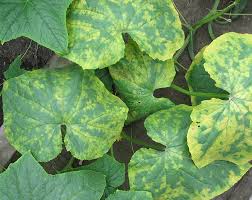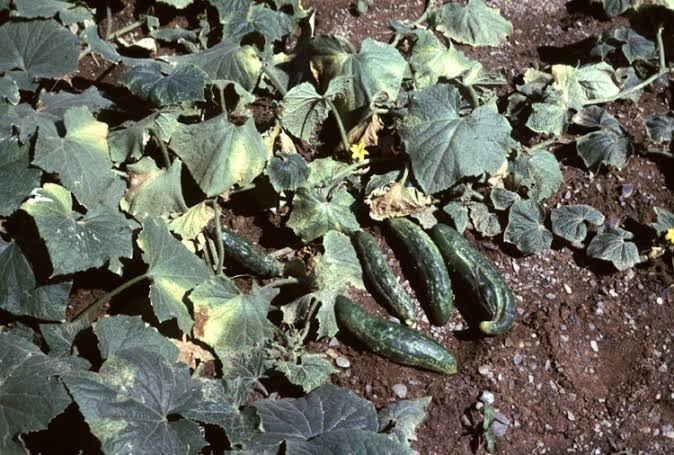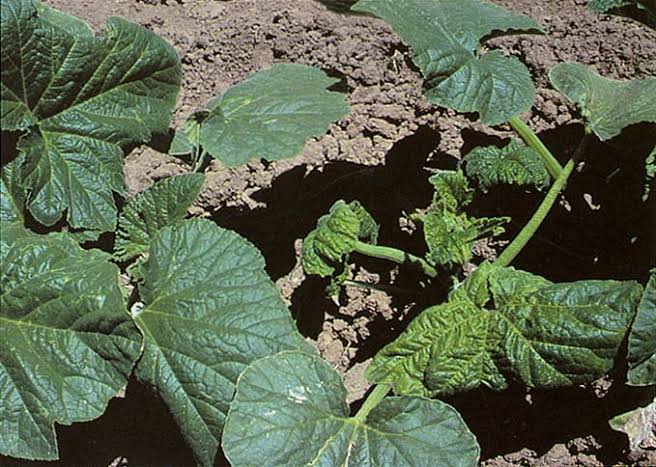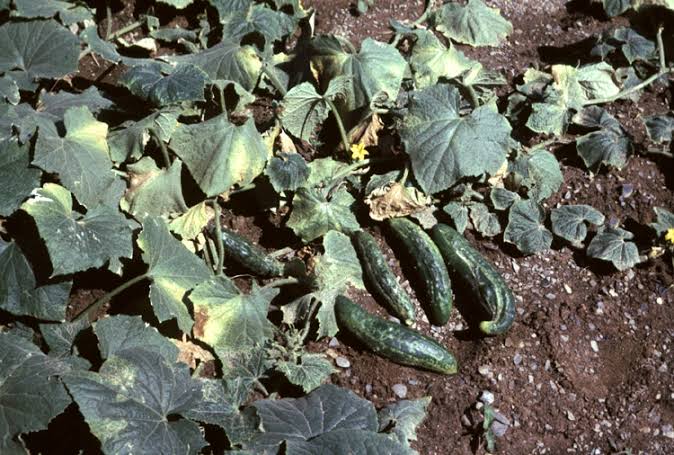Cucumber mosaic virus, scientifically known as CMV, is a plant pathogenic virus that affects a wide variety of crops, not just cucumbers. This microscopic invader can cause significant damage to plants, impacting their growth and overall health.
This virus is primarily spread through aphids, tiny insects that act as carriers. When aphids feed on an infected plant, they can pick up the virus and transmit it to healthy plants as they move from one plant to another. This rapid transmission makes CMV a formidable threat to many crops, including tomatoes, peppers, and melons.
Once a plant is infected with CMV, it may exhibit various symptoms depending on the type of plant and the severity of the infection. Common signs include mosaic patterns on leaves, stunted growth, and yellowing of plant tissues. These symptoms not only compromise the plant’s appearance but also impact its ability to photosynthesize and produce fruits.
Farmers face significant challenges in managing Cucumber mosaic virus due to its ability to infect a broad range of plants. Crop rotation, the practice of planting different crops in a sequence, is one strategy to reduce the risk of CMV spread. Additionally, controlling aphid populations through the use of insecticides can help minimize the transmission of the virus.
Scientists and researchers continually strive to develop resistant plant varieties to combat Cucumber mosaic virus. Through genetic engineering, they aim to create plants with enhanced immunity to the virus, providing a sustainable solution to this agricultural problem.
Cucumber mosaic virus is a troublesome pathogen with a broad host range, affecting various crops crucial to our food supply. Efforts to manage and mitigate its impact involve a combination of preventive measures, such as crop rotation and insect control, as well as ongoing research to develop resistant plant varieties. By understanding the dynamics of CMV and implementing effective strategies, farmers can work towards safeguarding their crops and ensuring a more resilient agricultural ecosystem.
Read Also: How to Establish an Apiary and Produce Honey
Plants Affected by Cucumber Mosaic Virus

Cucumber mosaic virus (CMV) has a wide host range, affecting numerous plant species across different families. The virus is known to impact both cultivated crops and ornamental plants. Some of the notable plants affected by Cucumber mosaic virus include:
1. Cucumbers (Cucumis sativus): As the name suggests, cucumbers are particularly susceptible to CMV. In infected cucumber plants, symptoms may include mosaic patterns on leaves, stunted growth, and reduced fruit production.
2. Tomatoes (Solanum lycopersicum): Tomatoes are commonly affected by CMV, leading to symptoms such as mosaic patterns on leaves, yellowing, and distortion. The virus can significantly reduce tomato yields.
3. Peppers (Capsicum spp.): Pepper plants, including bell peppers and chili peppers, can be infected by CMV. Infected plants may exhibit leaf mosaic, distortion, and reduced fruit quality.
4. Melons (Cucumis melo): Various melon species, including cantaloupes and honeydews, are susceptible to Cucumber mosaic virus. Infected plants may show mosaic patterns on leaves and stunted growth.
5. Squash (Cucurbita spp.): Squash plants, including zucchini and butternut squash, can be affected by CMV. Symptoms may include mosaic patterns on leaves and reduced fruit development.
6. Ornamental Plants: CMV also poses a threat to numerous ornamental plants, such as petunias, marigolds, and impatiens. In ornamental species, symptoms may include leaf mottling, yellowing, and stunted growth.
7. Lettuce (Lactuca sativa): Lettuce is among the leafy greens susceptible to CMV. Infected lettuce plants may exhibit symptoms such as mosaic patterns on leaves and reduced quality of the harvested leaves.
8. Beans (Phaseolus spp.): Certain bean species can be affected by Cucumber mosaic virus, leading to symptoms like leaf mosaic, curling, and reduced bean production.
It’s crucial for farmers, horticulturists, and gardeners to be aware of the diverse range of plants that can be impacted by CMV. Implementing preventive measures, such as monitoring for aphid vectors and using resistant plant varieties, can help mitigate the spread and impact of this widespread plant virus across various crops and ornamental species.
Damages Caused by Cucumber Mosaic Virus

Cucumber mosaic virus (CMV) can cause significant damage to infected plants, affecting both their appearance and productivity. The damages inflicted by CMV include:
1. Mosaic Patterns on Leaves: One of the hallmark symptoms of CMV infection is the development of mosaic patterns on the leaves of infected plants. This mosaic effect results from irregular coloration and patterning on the leaves, impacting the plant’s overall aesthetics.
2. Leaf Distortion: Infected plants often exhibit distorted leaves. This distortion can include curling, puckering, and twisting of the leaves, affecting their normal growth and function.
3. Stunted Growth: CMV can stunt the growth of infected plants. This is particularly detrimental in agricultural settings where plant size is directly linked to yield. Stunted plants may produce fewer fruits and have reduced overall biomass.
4. Yellowing of Plant Tissues: Yellowing, or chlorosis, is a common symptom of CMV infection. This occurs as the virus interferes with the plant’s ability to produce chlorophyll, affecting photosynthesis and leading to overall weakness in the plant.
5. Reduced Fruit Quality and Yield: For crops such as cucumbers, tomatoes, and peppers, CMV can significantly reduce the quality and quantity of harvested fruits. Fruits may be smaller, deformed, or exhibit other undesirable characteristics.
6. Transmission to Other Plants: CMV is easily transmitted by aphids, and infected plants serve as a source for further spread of the virus. This transmission can lead to a domino effect, affecting multiple plants in a given area.
7. Impact on Ornamental Plants: In ornamental plants, CMV can compromise the visual appeal of flowers and foliage. Infected ornamental plants may fail to achieve their full aesthetic potential, affecting landscaping and decorative plantings.
8. Economic Losses: The cumulative impact of CMV on crop yields and quality can result in economic losses for farmers and growers. Reduced productivity and marketable crop value contribute to financial challenges within the agricultural sector.
Effective management strategies, such as the use of resistant plant varieties, controlling aphid vectors, and implementing proper sanitation practices, are crucial in minimizing the damages caused by Cucumber mosaic virus. Early detection and prompt action can help mitigate the negative effects of this widespread plant virus on agriculture and horticulture.
Read Also: The Benefits of Beekeeping and Honey Production
Control and Preventive Measures

Controlling and preventing the spread of Cucumber mosaic virus (CMV) is essential for preserving the health and productivity of susceptible plants. Several measures can be employed to manage and mitigate the impact of CMV:
1. Use Resistant Varieties: Planting and cultivating crop varieties that are resistant to CMV can be an effective strategy. Resistant plants are less susceptible to infection, providing a natural defense against the virus.
2. Aphid Control: Since aphids are the primary vectors for CMV, managing aphid populations is crucial. This can be achieved through the use of insecticides, insecticidal soaps, and other pest control methods. Regular monitoring for aphid presence is also important.
3. Crop Rotation: Implementing a crop rotation strategy can help break the virus’s life cycle. Avoid planting susceptible crops in the same area consecutively, as this reduces the likelihood of CMV persisting in the soil and affecting subsequent crops.
4. Sanitation Practices: Practicing good sanitation is key to preventing CMV spread. Remove and destroy infected plants promptly to eliminate potential sources of the virus. This includes removing weeds that may harbor CMV.
5. Early Detection and Removal: Regularly inspect plants for symptoms of CMV, such as mosaic patterns, distortion, and yellowing. Early detection allows for the swift removal of infected plants, minimizing the risk of virus transmission.
6. Avoidance of Overhead Irrigation: CMV can be spread through contaminated water. To reduce the risk of water-mediated transmission, avoid overhead irrigation that can splash virus-infected sap from plant to plant.
7. Insect-Repellent Companion Plants: Intercropping with plants that repel aphids, such as certain aromatic herbs, can act as a natural deterrent to the vectors responsible for CMV transmission.
8. Genetic Engineering: Research is ongoing to develop genetically modified plants with enhanced resistance to CMV. These biotechnological approaches aim to provide long-term solutions by creating plants that are inherently less susceptible to the virus.
9. Education and Outreach: Educating farmers, gardeners, and horticulturists about CMV and its prevention is crucial. Awareness campaigns can promote the adoption of best practices and help minimize the spread of the virus.
By combining these control and preventive measures, it is possible to create a comprehensive approach to managing Cucumber mosaic virus. Integrated pest management strategies that incorporate both cultural and chemical methods can contribute to a more resilient and sustainable agricultural system.
Frequently Asked Questions (FAQs) About Cucumber Mosaic Virus
1. Q: What is Cucumber mosaic virus (CMV)?
A: Cucumber mosaic virus is a plant pathogenic virus that affects a wide range of plants, causing mosaic patterns on leaves, stunted growth, and other symptoms.
2. Q: How is CMV transmitted?
A: CMV is primarily transmitted by aphids, small insects that feed on infected plants and carry the virus to healthy plants as they move from one plant to another.
3. Q: Which plants are susceptible to CMV?
A: CMV has a broad host range, affecting various crops such as cucumbers, tomatoes, peppers, melons, squash, beans, lettuce, and many ornamental plants.
4. Q: What are the symptoms of CMV infection?
A: Symptoms include mosaic patterns on leaves, leaf distortion, stunted growth, yellowing of plant tissues, and, in some cases, reduced fruit quality and yield.
5. Q: How can I prevent CMV in my garden?
A: Preventive measures include using resistant plant varieties, controlling aphid populations, practicing crop rotation, maintaining good sanitation practices, and early detection and removal of infected plants.
6. Q: Can CMV be transmitted through water?
A: Yes, CMV can be spread through contaminated water. Avoiding overhead irrigation that can splash virus-infected sap helps reduce the risk of water-mediated transmission.
7. Q: Are there genetically modified plants resistant to CMV?
A: Research is ongoing to develop genetically modified plants with enhanced resistance to CMV, providing a biotechnological approach to managing the virus.
8. Q: What economic impact does CMV have on agriculture?
A: CMV can lead to economic losses for farmers due to reduced crop yields and quality, impacting the market value of affected crops.
9. Q: How can I identify CMV in my plants?
A: Look for mosaic patterns on leaves, leaf distortion, stunted growth, and yellowing. Regularly inspect plants, and if symptoms are observed, remove and destroy infected plants promptly.
10. Q: Can CMV be completely eradicated from an area?
A: Complete eradication of CMV from an area is challenging due to its ability to spread through aphids and the broad range of susceptible plant hosts. Management strategies focus on control and prevention.
Read Also: The Benefits of Weight Lifting for Weight Loss

